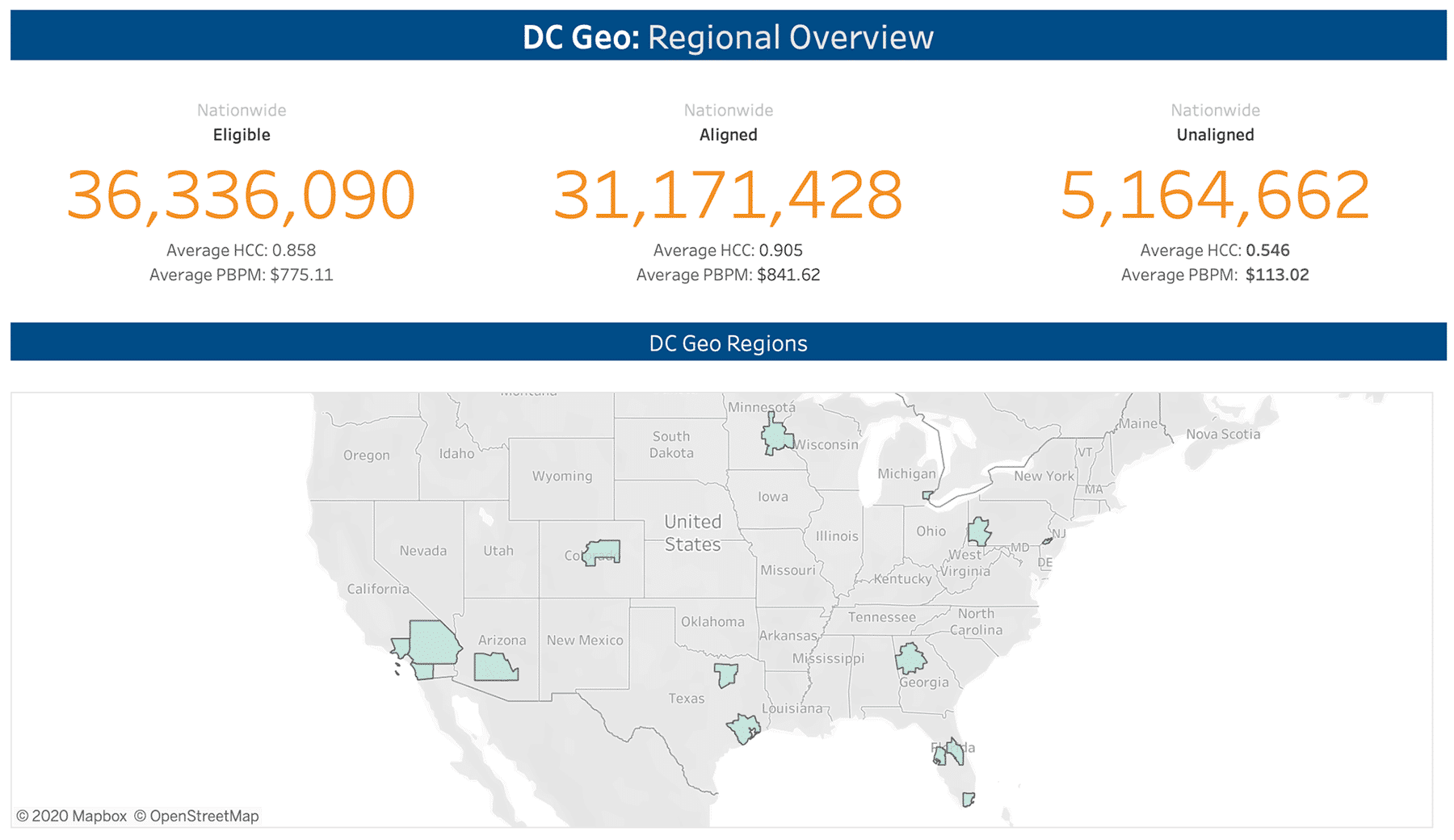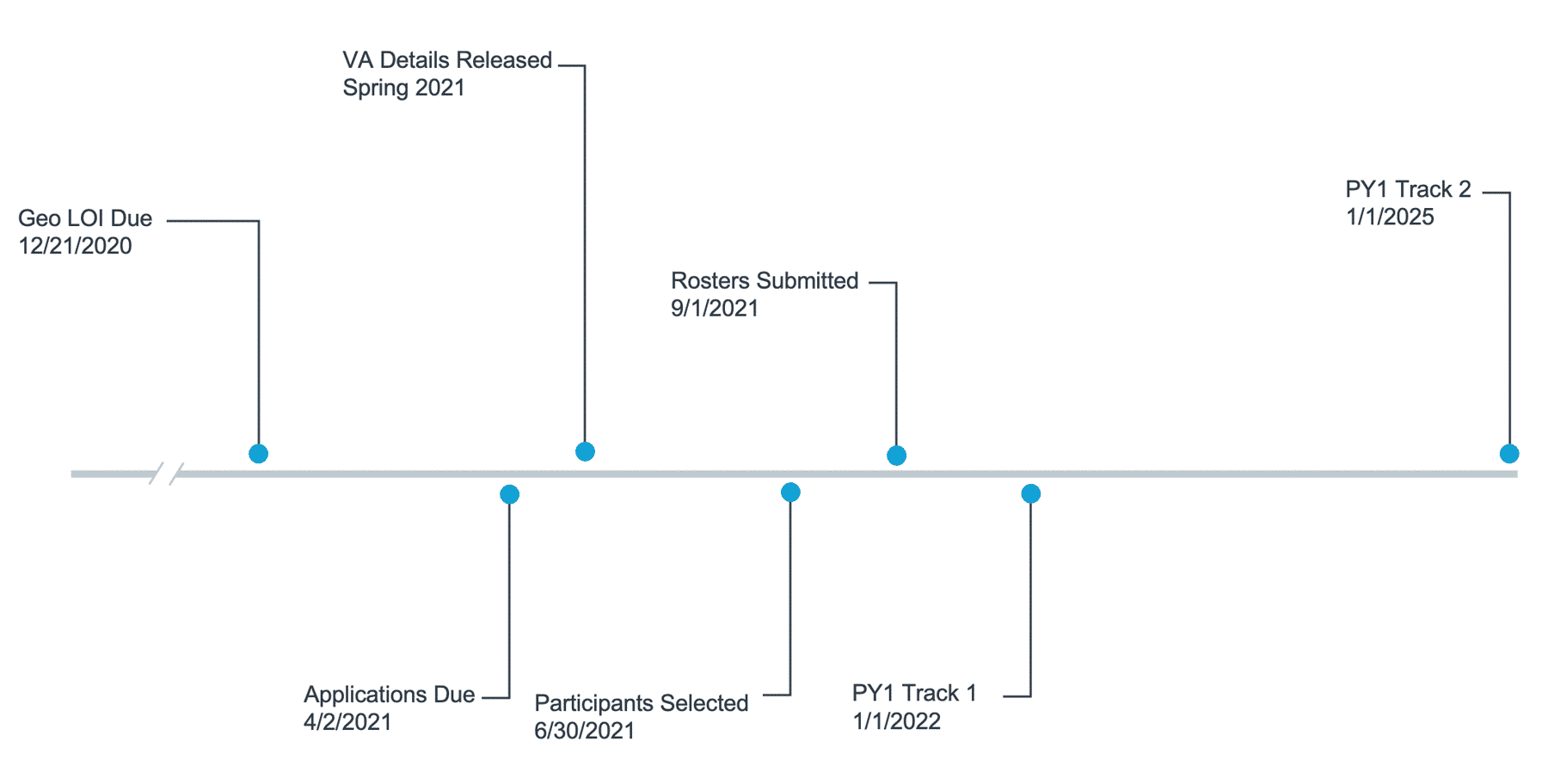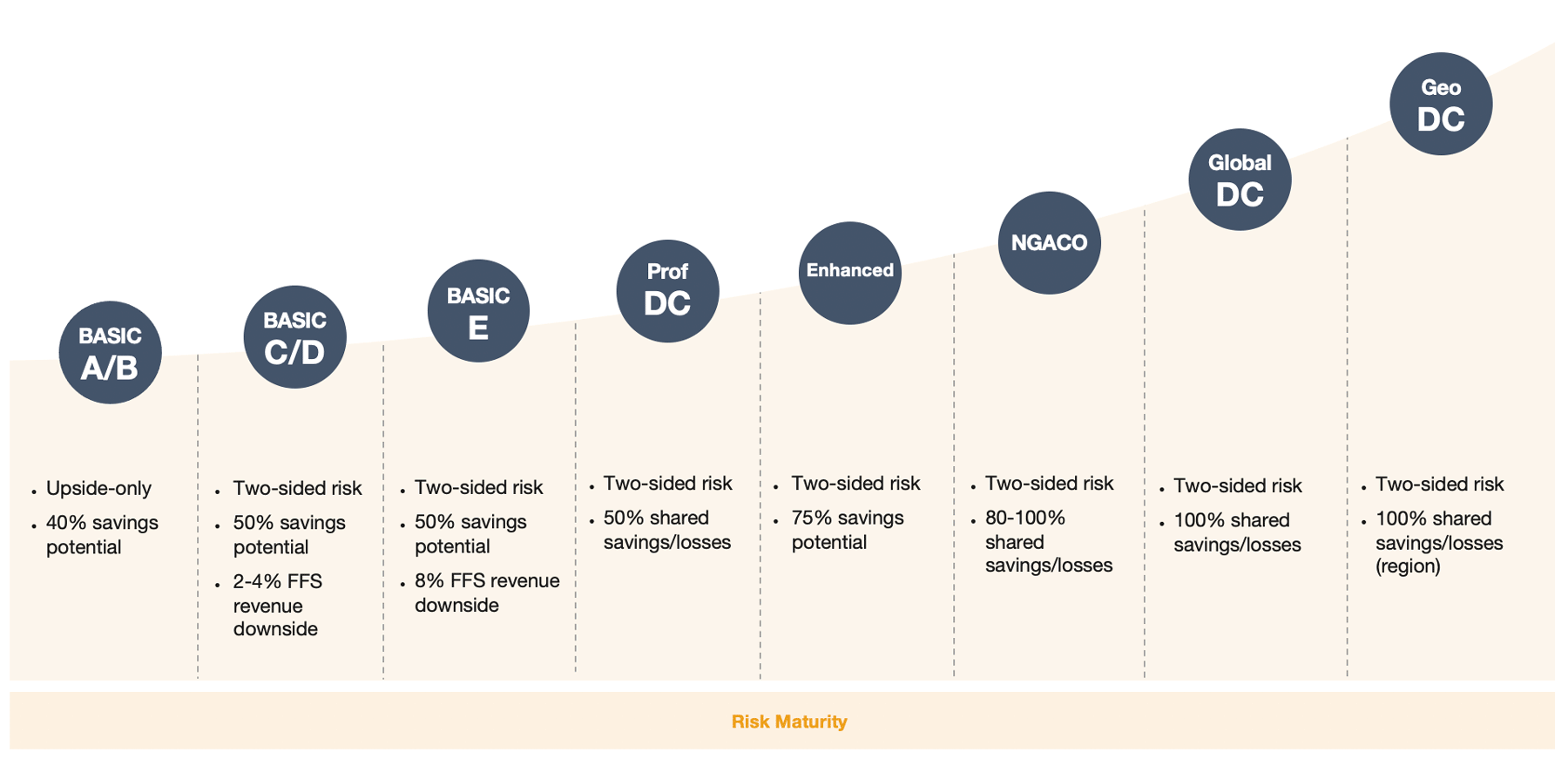How to Apply for the CMS GEO Direct Contracting Model
On December 3, 2020, Centers for Medicare & Medicaid Services (CMS) officially announced the release of the Geographic Direct Contracting Model (Geo), a highly anticipated option introduced at the outset of the Direct Contracting program, but subject to additional requests for information. We share industry enthusiasm for the model and appreciate the detailed approach on alignment and clarification on additional benefits.
This model aims to improve quality and lower costs for Medicare beneficiaries across an entire region. For the Geo model, CMS will define a region as a Core Based Statistical Area (CBSA). CMS aims for there to be a minimum of 3 Direct Contracting Entities (DCEs) per region and a maximum of 7, based on the volume of FFS beneficiaries.1
While the following write-up will dive into the specifics of the Geo Model, we will also address some comments and questions from our members with respect to the global and professional models as well.
Why Understanding Risk Scoring in the ACO REACH Model is Critical For Success
One major concern about the Direct Contracting model was risk scoring abuse. Read how the updated model plans to address risk scoring.

What is the Geographic Model?
Geo will test whether a geographic-based approach to value-based care can improve quality of care and reduce costs from Medicare beneficiaries across the entire region leveraging a set of best practices from prior Innovative models. Geo DCEs will be taking responsibility for the total cost of care for a set of Medicare beneficiaries in an entire region, thereby encouraging DCEs to partner with community organizations in a given region to create the most effective care network. The geo model will be tested over a six-year period with two three-year performance periods in a defined set of regions based on the submissions of letters of interest (LOIs) (due Dec 21, 2020). Fill out the form to understand, at a high level, what the eligible FFS population looks like in the defined 15 Geo regions.
While the global and professional DC models (as well as many other models) require an entity to take financial risk for a set of beneficiaries that see a particular group of providers, this model requires the entity to take financial risk for a portion of those doctors’ beneficiaries who reside in a specific geographic area. It’s clear that CMS is keen to test and understand how a geographic approach may improve value-based care with their release of the geo model as well as the release of the CHART model.
Please note that providers that choose not to enter into value-based arrangements with a Direct Contracting Entity will continue to be reimbursed at full Medicare fee-for-service rates.1
The 15 candidate regions that DCEs are allowed to operate in are as follows:1
| Atlanta | Los Angeles | Philadelphia |
| Dallas | Miami | Pittsburgh |
| Denver | Minneapolis | Riverside |
| Detroit | Orlando | San Diego |
| Houston | Phoenix | Tampa |
Below is a timeline with the critical dates that each Geo DCE needs to keep in mind.1

Why a Geographic Model?
A Geo model offers a variety of options for those considering submitting an LOI. While the Direct Contracting global and professional options allow for a number of valuable benefits, the geo model offers even more. Geo DCEs can lower beneficiaries’ out-of-pocket costs by reducing copayments or by offering a Part B premium subsidy if the beneficiaries voluntarily choose to visit the DCE’s preferred providers, essentially offering yet another option for beneficiaries that don’t enroll in a Medicare Advantage plan.
In addition to lowering beneficiaries’ out-of-pocket costs by visiting a Geo Preferred Provider, DCEs can also offer a variety of Care Coordination and Clinical Management tools, and can perform certain program integrity functions to ensure adherence to original Medicare policies as a means of reducing unnecessary services or payments. These tools are extensions from the existing benefits that are offered under the professional and global Direct Contracting options and are similar in kind to some of the benefits one might expect from a Medicare Advantage, an Individual and Family Plan, or a Managed Medicaid Organization. While the list of tools on the fact sheet is by no means exhaustive, it gives you a sense of what is possible. We’ve highlighted a few examples below.1
Prepaid, non-transferable vouchers for transportation: By nature of having the Geo DCEs operate in major CBSAs, some aligned beneficiaries will undoubtedly face some difficulties making it to their appointment. As a means to curb that difficulty, DCEs are eligible to leverage prepaid vouchers to transport their beneficiaries to and from their appointment with a provider.
Items and services to support management of a chronic disease or condition: While this is traditionally thought of as items like air purifiers, railings to prevent falls, etc., another option might be pest control services, carpet cleaning services, portable air conditioning units, dehumidifiers, or other items to improve the air quality or other management of chronic diseases.
Meal Vouchers: As a means to support beneficiaries with food security and nutritional needs, DCEs can offer vouchers to access meal programs such as Mom’s Meals or Meals on Wheels.
Phone applications for patient adherence to treatment regimens: Probably the most exciting of the bunch, DCEs can officially offer services such as Digital Medication Adherence to ensure adherence to treatment regimens, patient education materials and alerts to ensure compliance to your treatment regimen (i.e., cardiovascular exercise or blood sugar testing for diabetes), or SMART on FHIR apps with phone connectivity to both alert you to take an action (i.e., call your doctor if your blood pressure reading is unusually high) and record the entry into your DCE’s system of record for improved coordination. For more information on how your organization can take advantage of this benefit, please reach out to our Advisory Services team at advisory@carejourney.com.
Vouchers for Vision and Dental Care Services: The most common MA supplemental benefits are dental, vision and hearing with 97% of MA plans offering at least one, and half of all MA plans offering all three in 2019. DCEs can offer dental and vision services and compete with MA plans in a given region.
In addition, similar to the global and professional tracks, Geo DCEs are able to offer a $75 gift card (annual limit) as a means to incentivize participation in a chronic disease management program. Those DCEs who might opt to partner with a non-traditional healthcare provider (i.e., Smart Health Stations) may want to consider providing those gift cards to encourage usage of their services.
Alignment
While alignment in the global and professional tracks boil down to claims based and voluntary alignment, the Geo Model offers several other steps and requires a larger threshold. Each Geo DCE will be aligned with at least 30,000 beneficiaries with no maximum. Alignment can occur in a variety of ways to ensure you get to that 30,000 beneficiary threshold.1
- Voluntary Alignment: Similar to the Professional and Global options, Voluntary Alignment will be a critical component of the alignment process, giving beneficiaries the option to choose a participating provider as their doctor. Beneficiaries will have the option to voluntarily align both electronically or through paper-based forms. While the electronic interface can be clunky, it behooves DCEs in any track to optimize the workflow for beneficiaries to voluntarily align.
- MCO Based Alignment for Dually Based Beneficiaries: Since DCEs and their affiliates can operate Medicaid Managed Care Organizations, any dually-eligible beneficiaries will be aligned to the particular DCE that operates the Medicaid MCO (unless a beneficiary has voluntarily aligned to another DCE).
- ACO-Based Alignment (Capped): Geo DCEs cannot have more than 50% of their aligned beneficiaries also aligned to an ACO. Since DCEs are allowed to enter into an arrangement with an ACO participating in the Shared Savings Program, some of those beneficiaries could be aligned to the ACO and the DCE if the beneficiary resides in the DCE’s region.
- Claims Based Alignment (Capped): If a beneficiary hasn’t been aligned to one of the previous three methods, they may be aligned based on primary care services received from a DCE’s preferred providers via claims indicating an active relationship.Each DCE will be capped at 50% enrollment between ACO-Based and Claims-Based Alignment.
- Random Alignment: A new concept to the Geo model, any beneficiary that is not aligned in a previous method will be randomly aligned ensuring that each DCE meets the 30,000 beneficiary threshold.
Level of Maturity
It’s important to remember where we came from and to see the progression in shift to value that CMS has supported.2,3

Considering Applying?
If you’re considering whether or not the Geo model is an option for you, please consider taking part in the steps below to help you make the best decision for you. While the items below are targeted towards the Geo model, they have some applicability to the global and professional options as well.
- Submit an LOI. With limited time before LOIs are due on December 21st, you must make a decision quickly. If you don’t have experience and haven’t been thinking about Direct Contracting for very long, PY2022 for professional/global or track 2 of the Geo model is probably your best bet. That said, if you understand the financials of the other model options and are in a qualifying CBSA, consider submitting an LOI. Although you may be hesitant to do so, it is a non-binding LOI and CMS will use it to determine which of the 15 regions (4-10) will be selected for final participation.
- Start Thinking About Your Benefits Now! While you have some time to think about this, CMS has drawn a line in the sand and they are giving the power of choice to the beneficiary. Regardless of track, it’s clear VA needs to be a part of your strategy whether its a defensive or offensive play, and the benefits offered are an important part of success in this model. Competitive benefits can prevent loss and attract new beneficiaries and, more importantly, improve the care management and care coordination of your at-risk population. Looking at the participant regions, how saturated is the market with MA plans? Knowing that a majority of plans offer vision and dental benefits, considering including those as a baseline offering to compete. It’s important to understand the market and the offering, not only the other 2+ DCEs that will be entering the market.
- Model out the financials and understand your benchmark. This is critical to your application to ensure you understand the proposed discounts that you can offer. Since DCEs are going to be selected based on their proposed discounts (assuming that the DCE can carry out the requirements of the model), it’s critical to begin working this into your modeling so you can both propose the most competitive option while also ensuring you’re able to achieve financial success over the course of the performance period. While the minimum discount is 2% and max likely to be around 8-9%, it is expected that most DCEs will propose a 2-3% discount. This discount will use the national trend for the region and won’t be impacted by your prior year savings. The goal is to prevent the dynamics that we see as part of the MSSP program, where DCEs will have to compete against themselves to improve their bottom lines as opposed to those in the region they operate in. The discount also impacts the alignment volume or “enrollment allocation” that your DCE will receive. Those with a higher discount will receive a higher volume of aligned beneficiaries so DCEs submitting applications will need to consider their relative volume and discounts, making scenario planning a critical exercise.
- Surface opportunities for improvement. As you are responsible for 100% of the total cost of care for a subset of the region, what opportunities are you focused on to drive down the cost and improve the care for your beneficiaries? How are you planning to coordinate with your preferred providers to ensure you’re all moving with the same goal in mind knowing that there are likely several silos within your DCE (i.e., potentially different EHRs, no streamlined communication system, various care management platforms, etc.). Don’t forget to take advantage of the new OPPS rule and shift those previously IP-only services to the OP and ASC settings for another set of opportunities!
- Maximize the program design. Recognizing that the preferred provider list changes on an annual basis and that the program is only three years long, Geo DCEs are going to have to be nimble with their changes to take advantage of the short timeframe. In addition to the short timeframe, DCEs should also maximize the enhanced benefits the model offers to address the beneficiaries’ most critical needs.
Is the New Geo Model Right for You?
Fill out the form to view some of the most important information about the potential Geo markets before committing to participate. Are you entering with your eyes wide open?
For those deciding between Pathways and DC Professional, choose the one that you feel most prepared for and the one that provides the best chance to succeed. You may even want to join both! Consider a unique approach in which you form an ACO for Pathways but also form a smaller DCE. Please keep in mind your competition if that is the case.
How CareJourney Can Assist
Reach out to CareJourney for more information on how we can assist you in your Direct Contracting needs. Let us help you make the most informed decision for your organization in your move to value. Here’s how we can help:
- Model DC Attribution to help you understand alignment volumes
- Profile your regions and providers to understand the best partners
- Simulate your benchmarks to project your performance before finalizing your rosters
- Surface opportunities for Performance Improvement using your CMS supplied claims data
- CMS (December 2020). Geographic Direct Contracting Model (“Geo”) Fact Sheet. Retrieved from https://innovation.cms.gov/media/document/dc-geo-fact-sheet
- Milliman (March 2020). Direct Contracting: A program summary and comparison with MSSP and NGACO. Retrieved from https://www.milliman.com/-/media/milliman/pdfs/articles/direct_contracting_a_program_summary_and_comparison_with_mssp_and_ngaco.ashx
- CMS (Dec 21 2018).Final Rule Creates Pathways to Success for the Medicare Shared Savings Program. Retrieved from https://www.cms.gov/newsroom/fact-sheets/final-rule-creates-pathways-success-medicare-shared-savings-program
